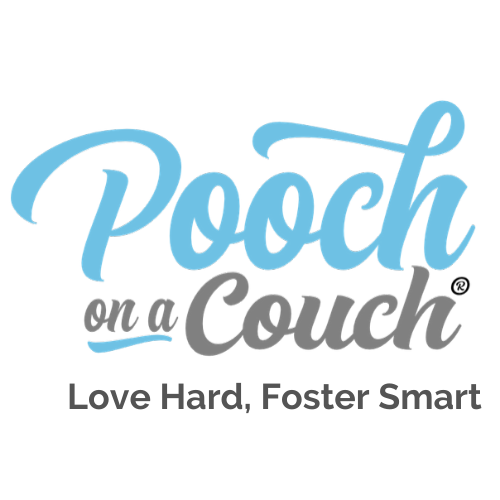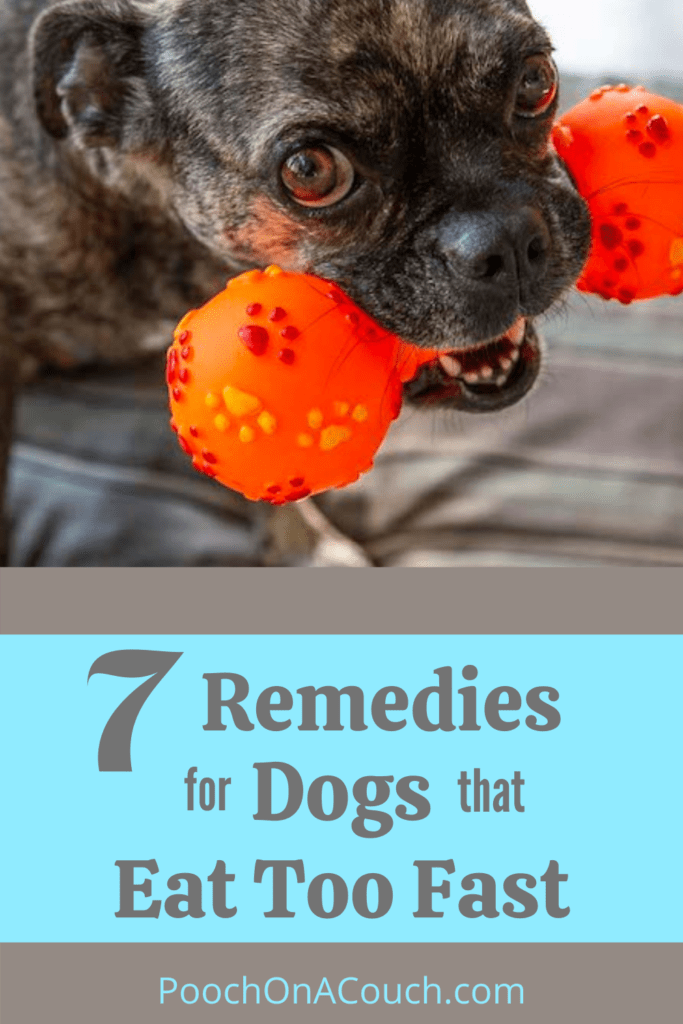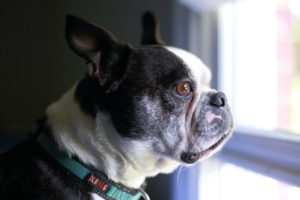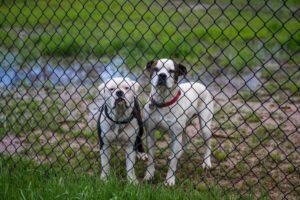Oh my. You just brought your foster dog home from the shelter, gave them dinner, and they are inhaling it! They finished their meal in seconds, and are now looking up at you for what – more?? You have a dog that eats too fast!
Or, maybe they gobbled up their meal and then immediately threw it all back up. Oh, lordy. Is your foster dog sick?
Are they eating so fast because they are starving, or they didn’t get fed a lot of food at the shelter, or they had to share the food bowl with other dogs in the shelter run? There is nothing more heartbreaking than wondering if your foster dog went without food, and we want to let them know right now that they will never, ever, have to go hungry again.
Understanding this behavior of scarfing down food will help you focus your observations and know when you need to intervene and help foster dogs that eat too fast.
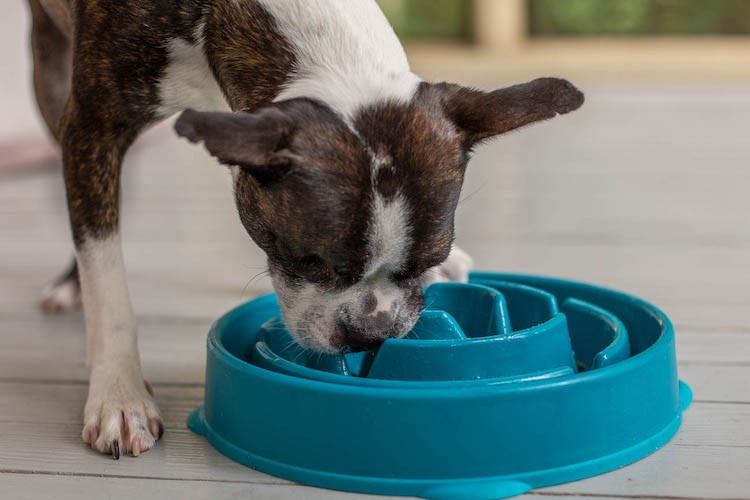
Why Do Dogs Eat Too Fast?
I’ve fostered over 40 dogs and I watch all of them eat. Most eat at a rather normal pace, and a few of them eat really, really slowly. Then there are those foster dogs that eat waaaaaay too fast and can finish their meal in mere seconds. Why do some dogs eat faster than others? Why do some inhale their food? Should we worry? Or care?
Let’s talk about why some dogs eat too fast. I did a little bit of research and the answer seems to be: they don’t really know why some dogs inhale their food.
But, we should not ignore this behavior. We should do something to change it. If you have a foster dog that eats too fast, read on, I’m sharing some helpful tips for you!
Dogs That Eat Too Fast: Were They Neglected?
Now, I couldn’t find any scientific research that would enable me to declare this a hard fact. A starved dog may act ravenous due to medical and metabolic reasons, (and you need to intervene) but in general neglect doesn’t seem to directly cause a dog to develop the behavior of eating too fast.
In fact, plenty of dogs who never experienced neglect are huge food gulpers.
So, why, then?
Maybe this behavior develops because of experiences as young puppies, competing over teets or when eating gruel out of communal bowls. Genetics probably plays a large role in the development of this behavior. Certain breeds of dogs seem more predisposed to gulping their food.
There may be medical issues that cause this behavior, so it’s definitely worth sharing your observations with your vet.
Finally, it may be a bad habit brought on by our caregiving style.
Why It’s A Problem If Your Foster Dog Eats Too Fast
- Dogs that eat too fast may choke on their food and die.
- Eating too fast may cause a dog to vomit up the meal. Daily vomiting is a problem even if the dog goes back and consumes it again. Gross, I know.
- A dog who eats too fast may have a medical condition that goes unchecked.
- Eating too fast may bring about a life-threatening condition called bloat, also called Gastric Dilation and Volvulus (GDV). Some dog breeds are genetically or anatomically predisposed to boat, but behaviors can also contribute to the development of bloat.
Why You Need To Intervene With Dogs That Eat Too Fast
First and foremost, you are keeping them safe and healthy.
It should go without saying, but when you are the caregiver of an agency’s dog you have a responsibility to observe problematic behavior and work towards a management plan.
It is fiscally responsible. If your foster dog develops a serious condition because they are eating food too fast, the agency has to redirect donor dollars to care for your now sick foster dog. An ER visit can add thousands of donated dollars to an agency’s debt.
It helps the family who adopts the dog. When you identify the best management plan for your foster dog and help your foster dog slow down when eating, you will pass this information on to the dog’s new family so they are equipped to keep their fast eater safe and healthy.
It is preventive behavior management. Finally, intervening with a management plan may help prevent the development of other behavioral issues such as obsessive behaviors or resource guarding.
How to Help Foster Dogs That Eat Too Fast
- Feed more than one meal a day.
Dogs that only eat one meal a day really are hungry by mealtime. Have you ever gone all day without eating and after sitting down to eat notice that you inhaled your food? Feeding a dog twice a day can help regulate a dog’s appetite and help them eat slower. Some experts suggest multiple small feedings a day, 3 even 4 meals each day. Watch your portions!
- Manage your dog’s arousal at mealtime.
- Don’t let your dogs hover at your feet as you prepare their meals. The more excited they are at the anticipation of being fed, the more excited they are when you put the food bowl down on the floor and the faster they are apt to eat.
- Feed at different times of the day. I vary when my dogs get fed by as much as an hour and a half. Some days I feed a half hour early, some days I might feed as much as an hour late. As a result, my dogs have become much more relaxed at mealtime and I have fewer conflicts.
- Consider feeding everyone in crates
I don’t always do this, but I usually foster dogs in low numbers. If I had a larger group of dogs, I’d probably give each dog their separate meal space.
Dogs do eat at different speeds and hover around waiting for other dogs to finish their meals. This might cause a dog to feel anxious and want to hurry up to avoid its meal being taken away.
I put distance in between crates when asking dogs to take their meals in there. Dogs do have a preferred personal space and I believe we should respect their boundaries, especially when feeding. - Use a special slow-feed bowl.
You can purchases these special bowls everywhere in all kinds of styles. If your budget allows, purchase several designs so your dog doesn’t get bored with just one pattern. If you are on a limited budget, there are some DIY ideas. Check Pinterest and YouTube for more ideas than you’ll need! - Use puzzle toys.
As mentioned with the feed bowls, there are many different toys you can buy that dispense kibble. For my fast eater, Carter, I use the Bob-A-Lot Treat Dispenser and put him in the kitchen behind a baby gate. He LOVES this toy!!
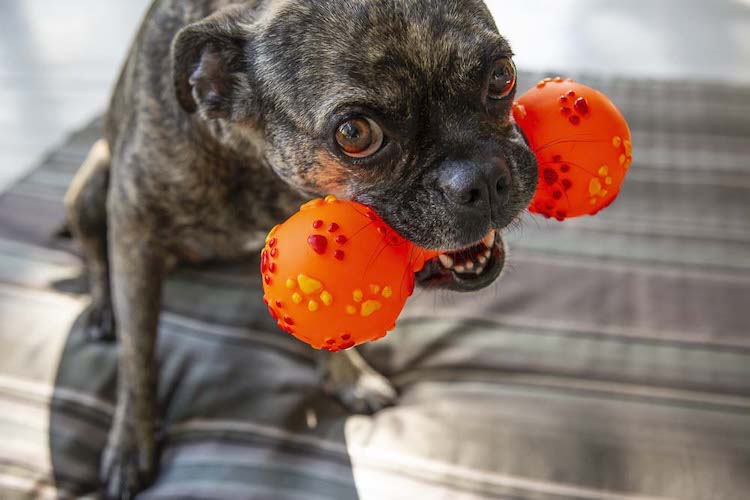
- Add water to kibble.
This does work for many dogs and helps them to slow down a bit. Perhaps it’s because dogs tend to drink the water first which helps settle the appetite, I’m just guessing, here. If you have a gulper, this is definitely worth a try. - Scatter their food.
I do this often. Because this requires a larger area for feeding, I usually set up this activity in the kitchen behind a baby gate or in an isolated room. You simply take the meal portion and scatter it around. Sometimes I use a washable rug (runner size) and scatter the kibble around the rug. Or I toss the kibble directly on the floor. If it’s my day to mop the kitchen floor, I don’t mind the slobber.
Don’t scatter their food in the yard. While this seems like the “species-appropriate” thing to do, it isn’t the best idea. Your dog likely won’t find all of their kibble, leaving an opportunity for rodents to hang around expecting to find food each night. If you don’t mind rodents, have at it.
Slobber not your thing? You can take the kibble and roll it up in a towel or yoga mat and the dog has to figure out how to unroll the mat in order to get the food. Not only is it a great way to slow down the dog’s feeding pace, but it’s a great opportunity to provide your dog a problem to solve. Dogs love to problem solve!
A snuffle mat is a foraging tool you might find a little less messy. These mats are easy and inexpensive to make, there are loads of DIY videos on youtube. A word of caution: some dogs may try to eat the fabric ribbons, so use snuffle mats only under close supervision.
My Preference? The Feeder Bowl Slows Down A Dog That Eats Too Fast
The feeder bowls are quick, easy, and much less messy. Most are dishwasher safe, making cleanup a breeze. As I mentioned earlier, if possible, get several designs. Your dogs will enjoy the challenge of figuring out the easiest way to get the kibble out of the bowl.
My dog, Otis was a dog that eats too fast. Sometimes, he’d throw up. Otis was also a toy hoarder and somewhat of a resource guarder. Every now and again, he didn’t want to share me. I didn’t know it then, but those types of behaviors were kind of interrelated.
I can’t promise this will happen to you, but I believe that feeding Otis from a slow-feed bowl helped him become a calmer dog. Over time, the act of eating slower PLUS the fact that I don’t make a big deal over meal times and don’t let him make a big deal over meal times helped him become less of a worrier.
Now, Otis shares his toys and he rarely has an incident where he protests sharing me with another dog (dog carefully chosen, that is!)
Bottom Line – Help Your Dog Eat Slower.
Find what works for your dog, each dog is different. Helping your dog eat slower will reduce risk and help them stay healthy.
We’d love to hear from you! Do you have a food gulper? What do you do to help your dog eat slower? Drop us a line!

Extra Credit Reading
Popular Posts
- HOW TO CHOOSE A DOG RESCUE AGENCY
- ULTIMATE GUIDE TO FOSTERING: 10 SKILLS YOU NEED
- VOLUNTEER IF YOU CANNOT FOSTER
